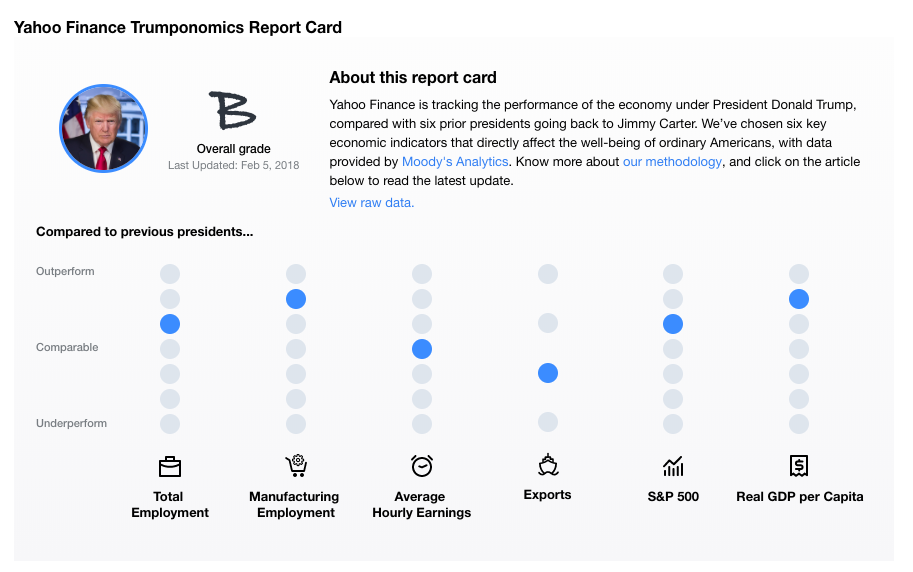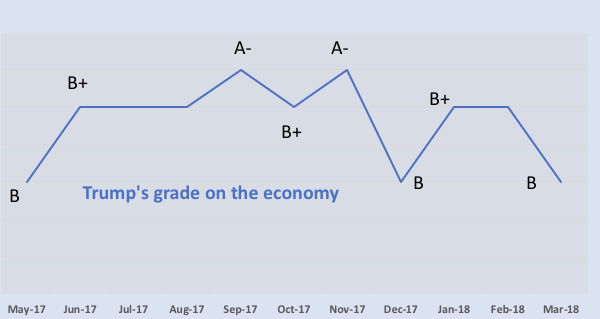What’s good and bad in the Trump economy
With the boffo jobs report for February, I expected President Trump’s grade to improve when we plugged the latest numbers into the Yahoo Finance Trumponomics Report Card.
But Trump’s grade fell by one notch, from B+ to B. What happened?
Here’s what: Trump’s ranking fell on three of our six indicators—exports, stock prices and earnings growth—while on jobs, it stayed where it is. Each month, we use data provided by Moody’s Analytics to compare the economy under Trump with its performance under six prior presidents at the same point in their terms. So it’s not purely a measurement of how the economy is doing. Rather, it’s a measure of how the Trump economy is doing compared with the Obama economy, the Bush economy, and so on, back to Richard Nixon in the 1970s. (Here’s our complete methodology.)
Here’s how Trump ranks on the latest report card:

On job growth, the Trump economy ranks third out of seven presidents, after Bill Clinton and Jimmy Carter. Trump has ranked third on that measure for 9 months out of 11, since we rolled out the report card last May. While the latest employment report was sizzling, with 313,000 new jobs created in February, the economy created even more jobs during the first 13 months of the Clinton and Carter presidencies.
On exports, Trump fell by one notch, and now ranks second out of four presidents (that data only goes back to 1993). On stock prices, Trump now ranks third, down from second last month. That reflects a 5.1% decline in the S&P 500 stock index in February. And on earnings, Trump now ranks fourth out of seven, down from third last month. On manufacturing employment and GDP growth, there was no change from the prior month.

Stocks have rebounded this month, so if that holds up, Trump’s grade could go back to B+ once the March numbers are in. It’s also worth noting that Trump ranks 2d in terms of manufacturing jobs created, which is impressive given that manufacturing is a smaller part of the overall economy than it was in the past.
On exports, it’s possible Trump could regain second place in coming months, because he’s neck and neck with Bill Clinton’s performance on that metric. But Trump’s new tariffs on steel and aluminum, which could trigger tariffs by other countries on U.S. exports, might get in the way, depressing exports more.
How much credit does Trump deserve for the performance of the economy? At this point, some. In general, presidents don’t control the economy as much as people often think. But the tax cuts Trump signed into law at the end of 2017 have boosted confidence and fueled spending. His tariffs and protectionist impulses, by contrast, could dampen economic activity if they make businesses nervous and lead to an escalating series of tit-for-tat duties on imports.
The economy can also turn quickly, making or breaking presidential fortunes. The economy under Carter, for instance, started strong but ended weak, contributing to his reelection loss in 1980. Reagan, by contrast, started with two years of job losses, followed by a recovery that helped clinch his 1984 reelection, and then, in 1988, a strong finish. So the beginning of a presidency doesn’t always look like the end.
Confidential tip line: rickjnewman@yahoo.com. Encrypted communication available.
Read more:
Rick Newman is the author of four books, including Rebounders: How Winners Pivot from Setback to Success. Follow him on Twitter: @rickjnewman
Follow Yahoo Finance on Facebook, Twitter, Instagram, and LinkedIn


